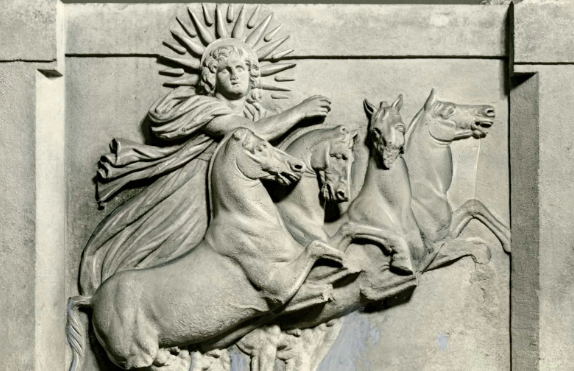
In ancient Greek religion, Helios was the god of the sun, often depicted as a powerful, radiant figure who drove a chariot across the sky each day. His role as the personification of the sun was central in Greek myth and was particularly important in the context of the sun’s daily journey across the heavens, which was thought to provide light and warmth to the world.
Origins and Symbolism:
Helios’ name itself is derived from the Greek word for the sun, “hēlios.” He is one of the primordial deities associated with the natural world and was often considered an early personification of the sun before Apollo was later associated with the sun in Greek mythology.
Helios is usually described as the child of the Titans Hyperion and Theia, both of whom were associated with the sky and light. Hyperion was often considered the Titan god of heavenly light, while Theia represented the divine light that illuminated the sky and the heavens. Their son Helios inherited this radiance, and his role as the sun god was to oversee the movement of the sun.
Depictions and Attributes:
Helios is typically depicted as a youthful, handsome god with a shining crown or halo, representing the sun. In artistic representations, he was shown riding a chariot drawn by four horses. These horses—often named Pyrite, Eous, Aethon, and Phlegon—drove the chariot across the sky each day, carrying the sun from the eastern horizon to the western one. This journey was often symbolized as a daily cycle of renewal, with Helios overseeing the passage of time.
Myths and Stories:
- Helios and the Sun’s Journey: The most famous myth about Helios involves his daily journey across the sky. As the sun god, he rode his chariot from the far east at dawn, traveling across the sky, and finally descending into the ocean at sunset, only to rise again in the morning. The idea of this cyclical movement was central to ancient Greek understandings of time and the passage of the day.
- The Tragedy of Phaethon: One of the most famous myths involving Helios is the story of his son, Phaethon. Phaethon, in his youth, sought to prove his divine parentage by driving the chariot of the sun. However, he was unable to control the powerful horses and steered too close to the Earth, causing devastation, including scorching parts of the world. To prevent further damage, Zeus struck him down with a thunderbolt, killing him. This myth symbolized the dangerous and uncontrollable power of the sun.
- Helios and the Odyssey: In the Odyssey, the sun god Helios plays a significant role in the tale of Odysseus’ journey home. The hero and his men, while stranded on the island of Thrinacia, are warned not to harm Helios’ sacred cattle. However, despite the warning, Odysseus’ men slaughter the cattle, which leads to their eventual destruction by Zeus as punishment for their disrespect of the sun god’s property.
Worship and Cults:
Helios was worshipped widely in the ancient Greek world, particularly in regions like Rhodes, where he had a major cult. One of the most famous landmarks in Greek history, the Colossus of Rhodes, was a giant statue dedicated to Helios, erected to celebrate the victory of the Rhodians over Cyprus in 305 BCE. It was one of the Seven Wonders of the Ancient World.
In addition to his cult in Rhodes, Helios was also venerated in other Greek cities. He was seen as a protector of oaths, justice, and divine order, partly due to his constant surveillance of the world from his position in the sky. His all-seeing nature made him a god who could watch over both mortals and immortals.
Helios vs Apollo:
While Helios was originally the main sun god in Greek mythology, over time, the role of the sun god became more closely associated with Apollo, especially in later periods of Greek mythology. Apollo, who had many other associations, including prophecy, music, and healing, eventually took on the attributes of the sun god, overshadowing Helios in many aspects of Greek religious thought. However, Helios remained a distinct figure, particularly in earlier myths and the traditional iconography of the sun.
In summary, Helios was a central figure in ancient Greek religion, symbolizing the sun and its vital role in sustaining life. His myths, cults, and the evolution of his character reflect the significance of the sun in both practical and symbolic terms for the ancient Greeks.